Tarayıcınızda o korkutucu “Güvenli Değil” uyarısını hiç gördünüz mü ve web siteniz için ne anlama geldiğini merak ettiniz mi? Bu yaygın bir endişe ve SSL ve HTTPS gibi teknik terimler bir çözüm bulmayı bunaltıcı hale getirebilir.
Binlerce kullanıcıya bu süreci adım adım rehberlik ettik ve iyi haber şu ki, sitenizi güvence altına almak düşündüğünüzden daha kolay. Bu, ziyaretçi güvenini artıran ve hatta arama sıralamalarında küçük bir yükseliş sağlayan basit bir değişikliktir.
Bu kılavuzda, WordPress sitenizi HTTP'den HTTPS'ye nasıl taşıyacağınızı adım adım anlatacağız. Her şeyi anlaşılır bir dilde açıklayacağız, böylece alan adınızın yanında güvenli asma kilit simgesini alabilirsiniz.
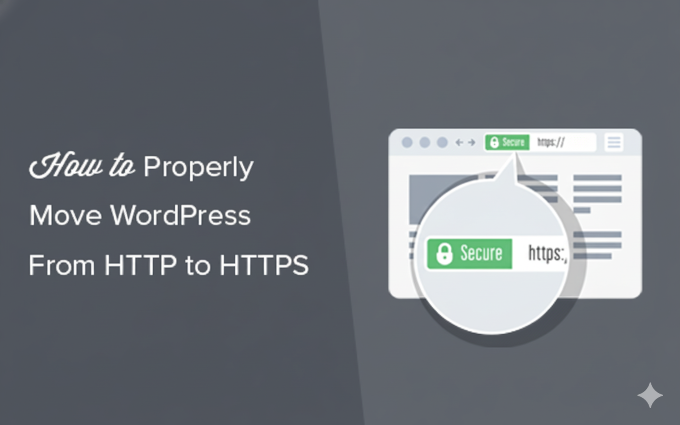
Hızlı Özet: WordPress'i 4 Adımda HTTPS'ye Taşıma
- Bir SSL sertifikası alın.
- Really Simple SSL gibi bir SSL eklentisi kurun ve etkinleştirin.
- Sitenizin HTTPS kullanması için ayarlarını güncelleyin.
- Yönlendirmeleri ayarlayın ve karışık içerik hatalarını düzeltin.
Bu makalede ele alacağımız konuların hızlı bir özetini aşağıda bulabilirsiniz:
- HTTPS Nedir?
- Neden HTTPS ve SSL'ye İhtiyacınız Var?
- Bir WordPress Sitesinde HTTPS/SSL Kullanımı Gereksinimleri
- WordPress'i SSL ve HTTPS Kullanacak Şekilde Ayarlama
- Yöntem 1: Bir Eklenti Kullanarak WordPress'te SSL/HTTPS Kurulumu
- Method 2: Set Up SSL/HTTPS in WordPress Manually
- Submit Your HTTPS Site to Google Search Console
- HTTPS'ye Taşıma Hakkında Sıkça Sorulan Sorular
- WordPress Güvenliği İçin Ek Kaynaklar
HTTPS Nedir?
HTTPS (Hypertext Transfer Protocol Secure), bir kullanıcının tarayıcısı ile web sitenizin sunucusu arasındaki bağlantıyı güvenli hale getiren bir şifreleme yöntemidir. Bu ek güvenlik, bilgisayar korsanlarının aktarılan verileri ele geçirmesini çok daha zorlaştırır.
Bu güvenli bağlantıyı oluşturmak için bir SSL (Secure Sockets Layer) sertifikasına ihtiyacınız vardır. "SSL" yaygın olarak kullanılan terim olsa da, günümüzde sitelerin kullandığı modern, daha güvenli teknoloji TLS (Transport Layer Security) olarak adlandırılır.
Her web sitesi kimlik doğrulaması için benzersiz bir SSL sertifikası alır. Bir sunucu geçerli bir sertifika olmadan HTTPS kullanmaya çalışırsa veya sertifika eşleşmezse, çoğu modern tarayıcı kullanıcılara uyarı verir ve devam etmemelerini tavsiye eder.
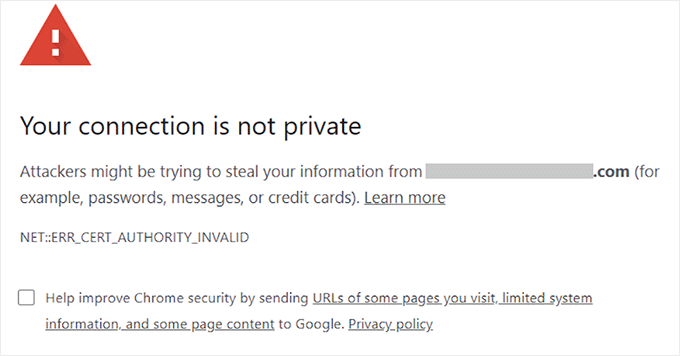
Neden HTTPS ve SSL'ye İhtiyacınız Var?
2018'de Google, site sahiplerini HTTP'den HTTPS'ye geçmeye teşvik ederek web güvenliğini artırma girişimini duyurdu. Bu hamleyi desteklemek için Chrome tarayıcısı, SSL sertifikası olmayan tüm web sitelerini "Güvenli Değil" olarak işaretlemeye başladı.
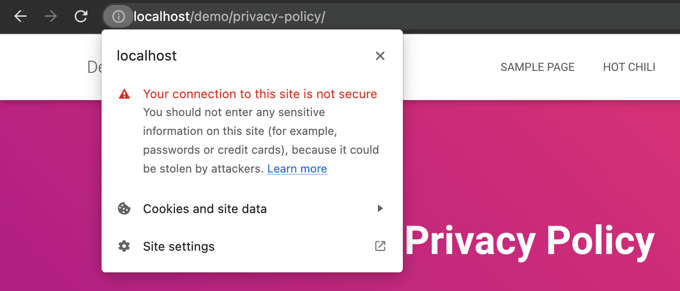
Bu “Güvenli Değil” uyarısı, özellikle birisi bir iletişim formu doldurmak gibi bilgi girmeye çalıştığında belirginleşir. Bu uyarıyı görmek olumsuz bir izlenim bırakabilir ve işletmenize olan güveni zedeleyebilir.
Bu nedenle tüm web sitelerinin HTTPS'ye geçmesi ve SSL yüklemesi gerekir. İşte başlıca faydaları:
- Geliştirilmiş Güvenlik: Ziyaretçileriniz ve sunucunuz arasında değiş tokuş edilen verileri şifreleyerek giriş kimlik bilgileri ve kişisel ayrıntılar gibi hassas bilgileri korur.
- Daha İyi SEO Sıralamaları: Google, güvenli HTTPS web sitelerine hafif bir sıralama avantajı sağlar.
- Kullanıcı Güveni Oluşturur: Tarayıcının adres çubuğundaki güvenli kilit simgesi, ziyaretçilere sitenizin gerçek ve güvenli olduğunu anında bildirir, bu da dönüşüm oranlarını artırabilir.
- Çevrimiçi Ödemeler İçin Gerekli: E-ticaret sitenizde çevrimiçi ödeme kabul etmek istiyorsanız, SSL Stripe, PayPal Pro ve Authorize.net gibi ödeme sağlayıcıları tarafından zorunlu tutulur.
Tüm kendi sitelerimizin, WPBeginner ve iş ortağı şirketlerimiz dahil olmak üzere SSL kullandığından emin oluyoruz.
Bir WordPress Sitesinde HTTPS/SSL Kullanımı Gereksinimleri
WordPress'te SSL kullanmanın gereksinimleri çok yüksek değil. Tek yapmanız gereken bir SSL sertifikası satın almak ve muhtemelen zaten ücretsiz olarak sahipsinizdir.
En iyi WordPress barındırma şirketleri tüm kullanıcıları için ücretsiz SSL sertifikaları sunmaktadır:
Daha fazla ayrıntı için, WordPress web siteniz için ücretsiz bir SSL sertifikası nasıl alacağınız hakkındaki rehberimize bakın.
Hosting şirketiniz ücretsiz bir SSL sertifikası sunmuyorsa, bir tane satın almanız gerekecektir.
SSL sertifikaları için en iyi teklifi sunduğu için Namecheap'i öneriyoruz.
Bir SSL sertifikası satın aldıktan sonra, barındırma sağlayıcınızdan onu sizin için kurmasını istemeniz gerekecektir.
WordPress'i SSL ve HTTPS Kullanacak Şekilde Ayarlama
Barındırma hizmetiniz alan adınız için bir SSL sertifikası etkinleştirdikten sonra, WordPress'i web sitenizde SSL ve HTTPS protokollerini kullanacak şekilde ayarlamanız gerekecektir.
Bunu yapmanız için size iki yöntem göstereceğiz ve ihtiyaçlarınıza en uygun olanı seçebilirsiniz.
Yöntem 1: Bir Eklenti Kullanarak WordPress'te SSL/HTTPS Kurulumu
Bu yöntem daha kolaydır ve yeni başlayanlar için önerilir.
Öncelikle, Really Simple SSL eklentisini kurmanız ve etkinleştirmeniz gerekir. Daha fazla ayrıntı için, bir WordPress eklentisinin nasıl kurulacağına dair adım adım kılavuzumuza bakın.
Etkinleştirdikten sonra Güvenlik sayfasını ziyaret etmeniz gerekir. Eklenti, SSL sertifikanızı otomatik olarak algılayacak ve size ‘SSL Etkinleştir’ seçeneğini gösterecektir.

Etkinleştirildikten sonra, eklenti karışık içerik hataları da dahil olmak üzere her şeyle ilgilenecektir.
Eklentinin arka planda yaptıklarına bir göz atalım:
- Geçerli bir SSL sertifikası olup olmadığını kontrol eder
- WordPress'in tüm URL'lerde https kullanacak şekilde ayarlar
- Yönlendirmeler kurar (HTTP'den HTTPS'ye)
- İçeriğinizdeki güvensiz HTTP kaynaklarından yüklenen URL'leri arar ve bunları düzeltmeye çalışır.
Not: Eklenti, çıktı tamponlama tekniği kullanarak karışık içerik hatalarını düzeltmeye çalışır. Bu, sayfa yüklenirken sitedeki içeriği değiştirdiği için olumsuz bir performans etkisi yaratabilir. Bu etki yalnızca ilk sayfa yüklemesinde görülür ve bir önbellekleme eklentisi kullanıyorsanız minimal olmalıdır.
Eklenti, SSL'yi koruyabileceğinizi ve eklentiyi güvenli bir şekilde devre dışı bırakabileceğinizi söylese de, bu %100 doğru değil. Eklentiyi her zaman aktif bırakmanız gerekecek çünkü eklentiyi devre dışı bırakmak karışık içerik hatalarını geri getirecektir. Daha fazla ayrıntı için Really Simple SSL incelememize bakın.
Yöntem 2: WordPress'te SSL/HTTPS'yi Manuel Olarak Ayarlama
Bu yöntem, sorunları manuel olarak gidermenizi ve WordPress dosyalarını düzenlemenizi gerektirir. Ancak, bu kalıcı, performansı optimize edilmiş bir çözümdür ve WPBeginner'da kullandığımız yöntem budur.
Bu yöntemi zor bulursanız, bir WordPress geliştiricisi kiralamalı veya bunun yerine ilk yöntemi kullanmalısınız.
Bu yöntemin bir parçası olarak tema ve kod dosyalarını düzenlemem gerekebilir. Bunu daha önce yapmadıysanız, WordPress'e kod parçacıkları kopyalayıp yapıştırma konusundaki rehberimize bakın.
Öncelikle Ayarlar » Genel sayfasına gitmelisiniz. Buradan, WordPress Adresi ve Site URL alanlarını http yerine https yazarak güncelleyin.
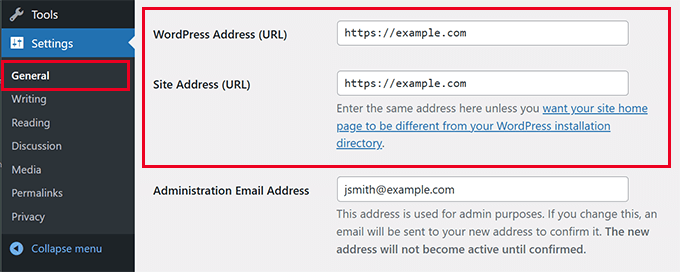
Ardından, yeni ayarları kaydetmek için 'Değişiklikleri Kaydet' düğmesine tıklayın.
Ayarlar kaydedildikten sonra WordPress sizi oturumdan çıkaracak ve yeniden oturum açmanız istenecektir.
Sonra, aşağıdaki kodu .htaccess dosyasına ekleyerek HTTP'den HTTPS'ye WordPress yönlendirmeleri kurun. Bu kod Apache sunucuları içindir:
NGINX sunucusundaysanız, yapılandırma dosyasına HTTP'den HTTPS'ye yönlendirme yapmak için aşağıdaki kodu ekleyeceksiniz:
example.com yerine alan adınızı (domain name) değiştirmeyi unutmayın.
Bu adımları izleyerek, WordPress HTTPS çalışmıyor hatasını önleyeceksiniz çünkü WordPress artık tüm web sitesini HTTPS kullanarak yükleyecektir.
WordPress yönetici alanına veya giriş sayfalarına SSL ve HTTPS'yi zorlamak için, SSL'yi wp-config.php dosyasında yapılandırmanız gerekir.
Aşağıdaki kodu wp-config.php dosyasındaki “Hepsi bu kadar, düzenlemeyi bırakın!” satırının üzerine ekleyin:
define('FORCE_SSL_ADMIN', true);
Bu sabit, bir güvenlik önlemi görevi görür. WordPress oturum açma sayfanızın ve kontrol panelinizin her zaman şifrelenmiş olmasını sağlayarak site yöneticisi için ekstra bir güvenlik katmanı ekler. Ayrıca WordPress çoklu site ağlarında da çalışır.
Bu yapıldıktan sonra, web sitesi SSL / HTTPS kullanmak üzere tamamen ayarlanmış olur, ancak yine de karışık içerik hatalarıyla karşılaşabilirsiniz.
Karışık İçerik Hatalarını Düzeltme
Karışık içerik hataları, bazı içeriklerin (resimler, betikler veya stil sayfaları gibi) HTTPS yerine güvensiz HTTP protokolü üzerinden yüklenmesiyle oluşur.
Bunu, güvenli, zırhlı bir ön kapınız (HTTPS) varken bir pencereyi kilitsiz bırakmak gibi düşünebilirsiniz (bir HTTP kaynağı). O tek kilitsiz pencere, tüm evi savunmasız bırakır.
Bu olduğunda, web sitenizin adres çubuğunda güvenli bir kilit simgesi görmezsiniz.

Tarayıcınızın İncele aracı ile güvensiz bir protokol üzerinden hangi içeriğin sunulduğunu öğrenebilirsiniz.
Karışık içerik hatası, konsolda bir uyarı olarak ve her öğe için ayrıntılarla görüntülenecektir.
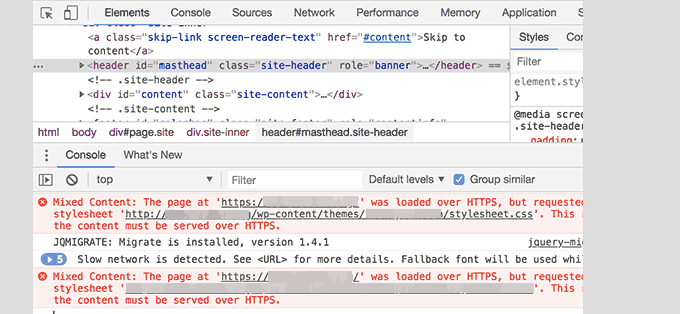
URL'lerin çoğunun resimler, iframe'ler ve resim galerileri olduğunu, bazılarının ise WordPress eklentileri ve temaları tarafından yüklenen betikler ve stil sayfaları olduğunu fark edeceksiniz.
WordPress Veritabanında Karışık İçeriği Düzeltme
Yanlış URL'lerin çoğu, WordPress veritabanında depolanan resimler, dosyalar, yerleştirmeler ve diğer veriler için olacaktır. Önce onları düzeltelim.
Veritabanında HTTP ile başlayan eski web sitenizin URL'sinin tüm örneklerini bulmanız ve bunları HTTPS ile başlayan yeni web sitenizin URL'si ile değiştirmeniz gerekir.
Bunu, Search & Replace Everything eklentisini yükleyip etkinleştirerek kolayca yapabilirsiniz.
Etkinleştirme sonrasında, Araçlar » WP Arama ve Değiştirme sayfasına gidin. ‘Arama’ alanına http ile web sitenizin URL'sini ve ‘Değiştir’ alanına https ile URL'nizi eklemeniz gerekir.
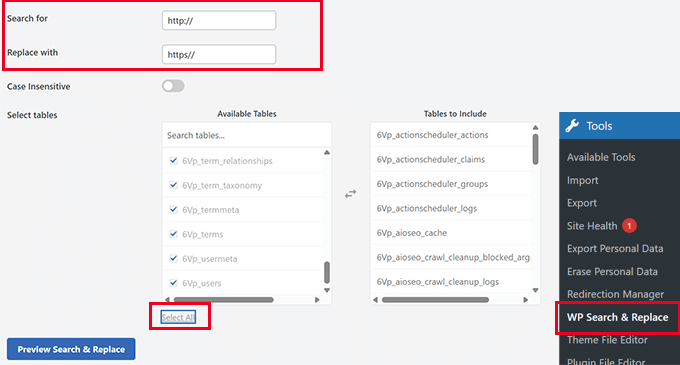
Ardından, kapsamlı bir kontrol çalıştırmak için tüm veritabanı tablolarını seçin ve ‘Tümünü Değiştir’ düğmesine tıklayın. Eklenti şimdi veritabanındaki tüm eski URL'leri güncelleyecektir.
WordPress Temasından Kaynaklanan Karışık İçerik Hatalarını Düzeltme
WordPress kodlama standartlarını takip eden herhangi bir iyi WordPress teması bu soruna neden olmaz. Ancak, bazıları hala güvensiz URL'leri kodlayabilir.
İlk olarak, kaynakları ve nereden yüklendiklerini bulmak için tarayıcının İncele aracını kullanmanız gerekecektir. Bundan sonra, bunları WordPress temanızda bulmanız ve http'yi https ile değiştirmeniz gerekecektir.
Bu, çoğu yeni başlayan için biraz zor olacaktır, çünkü bu URL'leri hangi tema dosyalarının içerdiğini göremeyebilirsiniz.
Eklentilerden Kaynaklanan Karışık İçerik Hatalarını Düzeltme
Bazı karışık içerik kaynakları WordPress eklentileri tarafından yüklenecektir. WordPress kodlama standartlarını takip eden herhangi bir WordPress eklentisi karışık içerik hatalarına neden olmaz.
WordPress eklenti dosyalarını düzenlemenizi önermem. Bunun yerine, eklenti yazarıyla iletişime geçmenizi ve durumu bildirmenizi öneririm. Yanıt vermezlerse veya sorunu düzeltemezlerse, uygun bir alternatif bulurdum.
Not: Eğer bir nedenle hala karışık içerik hatasıyla karşılaşıyorsanız, sorunu bir hazırlık sitesinde düzeltirken veya bir geliştiriciyle çalışırken kullanıcılarınızın etkilenmemesi için Really Simple SSL eklentisini geçici olarak kullanmanızı öneririz.
HTTPS Sitenizi Google Search Console'a Gönderin
Google gibi arama motorları https ve http'yi iki farklı web sitesi olarak ele alır. Herhangi bir SEO sorununu önlemek için web sitenizin taşındığını Google'a bildirmeniz gerekecektir.
Bunu yapmak için, yalnızca Google Search Console hesabınıza gitmeniz ve ‘Özellik ekle’ düğmesine tıklamanız yeterlidir.
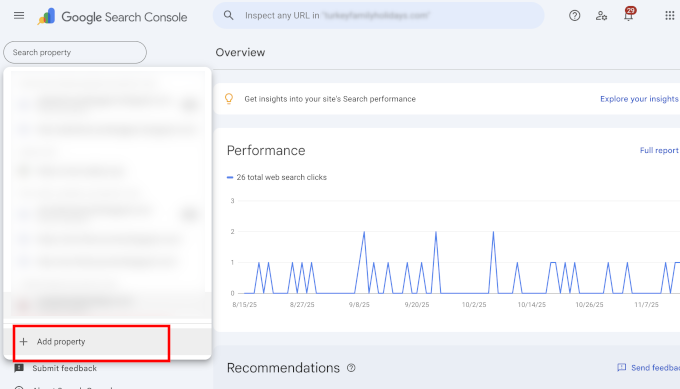
Bu, web sitenizin yeni HTTPS adresini eklemeniz gereken bir açılır pencere getirecektir.
Google sitenizi doğrulamak için çeşitli yollar sunar, ancak URL öneki yöntemini öneririz çünkü daha esnektir.
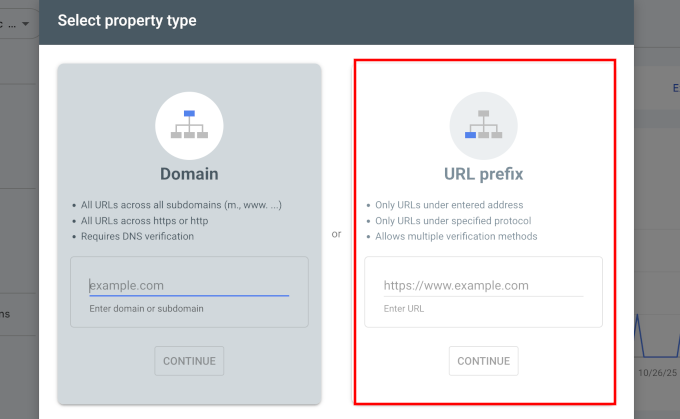
Bundan sonra Google sizden web sitenizin sahipliğini doğrulamanızı isteyecektir.
Bunu yapmanın birkaç yolu vardır, ancak HTML etiket yöntemini kullanmanızı öneririz. WordPress sitenize eklemek için bir HTML kod parçacığı alacaksınız.
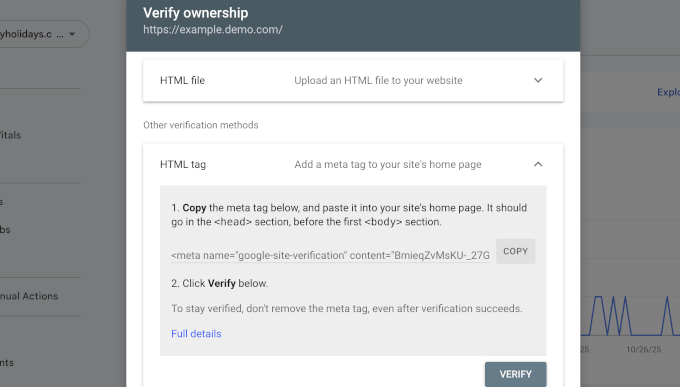
All in One SEO ile Arama Konsolu Doğrulama Kodunu Ekleme
İlk olarak, All in One SEO for WordPress eklentisini yükleyin ve etkinleştirin. Daha fazla ayrıntı için, bir WordPress eklentisinin nasıl kurulacağına dair eğitimimize bakın.
Uzman İpucu: WPBeginner'da tüm web sitelerimizde All in One SEO kullanıyoruz. Webmaster Araçları doğrulama özelliği bize çok zaman kazandırıyor, çünkü kodu yapıştırabiliyoruz ve AIOSEO otomatik olarak sitemizin başlığındaki doğru yere ekliyor.
Etkinleştirdikten sonra, All in One SEO » Genel Ayarlar sayfasına gidin ve Webmaster Araçları sekmesine tıklayın. Oradan, Google Search Console'a tıklayın.
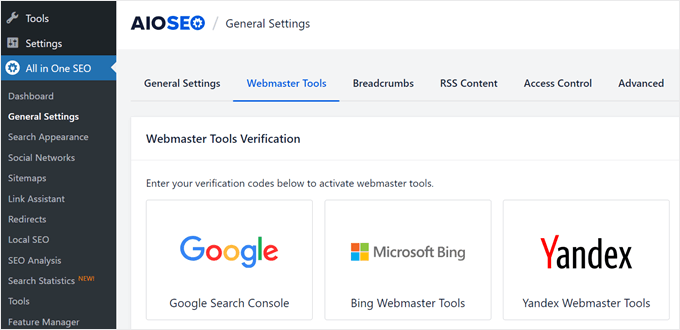
Buraya, daha önce Google Search Console web sitesinden kopyaladığınız doğrulama kodunu eklemeniz gerekir. Ayarlarınızı kaydetmek için 'Değişiklikleri Kaydet' düğmesine tıklamayı unutmayın.
Ardından, Google Search Console sekmesine geri dönün ve ‘Doğrula’ düğmesine tıklayın. Siteniz doğrulandıktan sonra Google, Arama Konsolu raporlarınızı göstermeye başlayacaktır.
Ayrıca hem https hem de http sürümlerinin Arama Konsolu'na eklendiğinden emin olmanız gerekir.
Bu, Google'a web sitenizin https sürümünün birincil sürüm olarak kabul edilmesini istediğinizi söyler. Daha önce ayarladığınız 301 yönlendirmeleriyle birlikte Google, arama sıralamalarınızı web sitenizin https sürümüne aktaracaktır.
HTTPS'ye Taşıma Hakkında Sıkça Sorulan Sorular
SSL sertifikası ne kadar?
Bir SSL sertifikası ücretsiz olabilir. En iyi WordPress barındırma şirketlerinin çoğu, Let's Encrypt aracılığıyla tüm müşterilerine ücretsiz SSL sertifikaları sunar. Barındırma hizmetiniz ücretsiz bir tane sunmuyorsa, düşük bir yıllık ücret karşılığında Namecheap gibi bir sağlayıcıdan bir tane satın alabilirsiniz.
SSL ve HTTPS arasındaki fark nedir?
SSL (Secure Sockets Layer), verileri şifreleyen teknolojidir. HTTPS (Hypertext Transfer Protocol Secure), bu SSL teknolojisinin kullanılmasının sonucudur. Bir web sitesi geçerli bir SSL sertifikasına sahip olduğunda, URL'si https:// ile başlar ve tarayıcıda bir kilit simgesi görünür, bu da bağlantının güvenli olduğunu gösterir.
HTTPS kullanmazsam ne olur?
HTTPS kullanmazsanız, Google Chrome gibi modern tarayıcılar ziyaretçilerinize “Güvenli Değil” uyarısı gösterecektir. Bu, güveni zedeleyebilir, marka itibarınıza zarar verebilir ve potansiyel müşterilerinizi kaybetmenize neden olabilir. Ek olarak, HTTPS'ye sahip olmamak arama motoru sıralamalarınızı olumsuz etkileyebilir.
WordPress Güvenliği İçin Ek Kaynaklar
Aşağıda, yaygın WordPress sorunlarını gidermenize ve web sitesi güvenliği hakkında daha fazla bilgi edinmenize yardımcı olabilecek bazı ek kaynaklar bulunmaktadır:
- WordPress'te Yaygın SSL Sorunları Nasıl Giderilir (Yeni Başlayanlar İçin Rehber)
- En Yaygın WordPress Hataları ve Bunları Düzeltme Yolları
- WordPress'te Güvenli Bağlantı Hatası Nasıl Düzeltilir
Umuyoruz ki bu makale WordPress'e HTTPS ve SSL eklemenize yardımcı olmuştur. WordPress sitenizi güvende tutmak için adım adım talimatlar içeren nihai WordPress güvenlik rehberimize veya SSL sertifikanızı nasıl yenileyeceğinize dair rehberimize de göz atmak isteyebilirsiniz.
Bu makaleyi beğendiyseniz, lütfen WordPress video eğitimleri için YouTube Kanalımıza abone olun. Bizi ayrıca Twitter ve Facebook'ta da bulabilirsiniz.





Kevin Bollhorst
Bu bilgilendirici makale için teşekkürler. Blogumu SSL'ye geçirmeyi düşünüyorum. Web barındırma sağlayıcım Bluehost ve ücretsiz Cloudflare CDN Hizmetini kullanıyorum. Bir sorum var. Cloudflare'ın ücretsiz hizmeti Bluehost'un Ücretsiz SSL sertifikasını destekleyecek mi?
WPBeginner Desteği
Merhaba Kevin,
Lütfen Bluehost veya Cloudflare desteğiyle iletişime geçin, ücretsiz Cloudflare CDN'nizle SSL'in çalışması için ek yapılandırmaya ihtiyacınız olabilir.
Yönetici
Moritz Steiger
Bu talimatları izledim ve şimdi sitemi mahvetti, hiçbir şey çalışmıyor. Şimdi 'Ölüm beyaz ekranı' hatası alıyorum, barındırma sağlayıcım yardım etmiyor çünkü bunun bir kodlama hatası olduğunu söylüyorlar ve ben ortada kaldım.
WPBeginner Desteği
Merhaba Moritz,
Bunu duyduğumuza üzüldük. Lütfen öğreticiyi takip ederken attığınız adımları tek tek geri alın, bu sitenizi normale döndürecektir.
Yönetici
Chandra
Merhaba,
Çok sıcak bir konu hakkında bu kadar ayrıntılı bir makale için teşekkürler.
Manuel adımları izledim ancak karışık içerik hatası aldım. Ve bunun yüzünden WP giriş sayfasını göremediğim anlaşılıyor. Dreamhost'ta önbelleği temizlemeyi denedim ancak görüntülenen mesaj "CloudFlare'e bağlanılamıyor".
Dreamhost kullanıyorum ve Cloudflare etkin.
Sorunu düzeltmek için lütfen yardım eder misiniz veya daha fazla ayrıntıya ihtiyacınız var mı? Başka bir sitemi güvence altına almak için ücretli hizmet de sunuyor musunuz?
Teşekkürler.
WPBeginner Desteği
Merhaba Chandra,
Lütfen Cloudflare ayarlarınızı gözden geçirin.
Yönetici
Richard
Merhaba,
Manuel prosedürü sorunsuz bir şekilde takip ettim – Teşekkürler!
Ancak, ana sayfa dışındaki herhangi bir sayfa için tarayıcıya eski http:// adresini yazdığımda eski http:// sayfasının yüklendiğini fark ettim.
Then when I click a link to another page it goes to a https:// page is this normal?
Yönlendirme ile ilgili bir sorun olduğunu mu gösteriyor?
WPBeginner Desteği
Merhaba Richard,
Hayır, değil. Büyük olasılıkla .htaccess dosyanızdaki yönlendirmeler çalışmıyor. Kodu kopyalayıp tekrar .htaccess dosyanıza eklemeyi deneyin ve sorunun çözülüp çözülmediğini görün.
Yönetici
Richard
Merhaba,
Fixed It thanks. I’d originally inserted the Code at the end of the htaccess file. Moved It Up to before the WP section and everthing now works correctly.
Yardımlarınız ve özlü rehberiniz için teşekkürler. Bunu bir süredir erteliyordum.
Daniel
Google Console'daki son adım olan “Adres Değişikliği” sayfasında, http ve https sürümlerinin doğrulandığını iki kez kontrol etmeme rağmen “uygun site yok” mesajı alıyorum. “Şimdi ekle”ye tıkladığımda sadece doğrulama bilgileri geliyor. Ne yapmalıyım?
Emily Randall
Web siteme bir LetsEncrypt sertifikası yükledim ve olmaması gereken bir sürü güvensiz içerik hatası alıyorum. Tema, stillerini ve betiklerini yüklemek için get_template_directory_uri() kullanmasına rağmen, bu stiller ve betikler hala http üzerinden yükleniyor, https üzerinden değil. Stilleri/betikleri yüklemek için fonksiyonda https URL'sini sabit kodlasam bile, http üzerinden yükleniyorlar.
Burada neler olduğunu biliyor musunuz? Anladığım kadarıyla her şey düzgün ayarlanmış, ancak çalışmıyor.
WPBeginner Desteği
Merhaba Emily,
WordPress önbelleğini temizlemeyi deneyin.
Yönetici
skaur
Merhaba,
SSL sertifikası satın aldım ve hostingim tarafından yapılandırıldı. URL'de https görünüyor. WordPress yönetici alanındaki Genel ayarlar altında https'yi seçtiğimde, web sitem kapanıyor, sadece ana sayfa açılıyor ve sonrasında yönetici alanına giriş yapamıyorum. Ayarlar altında https ile birlikte htaccess dosyasına da kod ekledim.
Bana bu konuda yardımcı olabilir misiniz?
Teşekkürler
stan
https://support.google.com/webmasters/answer/83106 şunu belirtiyor:
Not: Araç şu anda aşağıdaki site taşıma türlerini desteklememektedir: alt alan adı değişiklikleri, protokol değişiklikleri (HTTP'den HTTPS'ye) veya yalnızca yol değişiklikleri.
WPBeginner Desteği
Merhaba Stan,
Evet, bunun farkındayız. Ancak yine de bu adımı atmanızı öneririz. Güvenlidir ve siteniz üzerinde herhangi bir olumsuz etkisi olmayacaktır.
Yönetici
Lindsey Bell
Web barındırma için Bluehost kullanıyorum ve Bluehost sayfasından ücretsiz SSL sertifikası ile WordPress sitemi kurdum. Bluehost sitesinde WordPress sitem için etkinleştirmek üzere bir sayfa vardı. Şimdi, sitemin zaten https ile kurulmuş görünüyor. Eklentiyi hala yüklemem gerekiyor mu, yoksa benimki zaten halledildi mi? Yardımlarınız için çok teşekkürler!
WPBeginner Desteği
Merhaba Lindsey,
Eklentiyi hala yüklemeniz gerekiyor.
Yönetici
Farukh hussain
Merhaba,
Bu sorunla karşılaşıyordum ve siz de az önce bu makaleyi yüklediniz. Çok teşekkürler.
Yardımcı olabilir misiniz? Arama konsolunda ana sitemi değiştirmedim. https ile yeni bir özellik ekledim ve sonra hepsini kapsayan bir set oluşturdum. Sıralama için iyi çalışacak mı yoksa sadece talimatlarınızı mı takip etmeliyim???
WPBeginner Desteği
Merhaba Farukh,
HTTPS özelliğini eklemek ve ardından kullanıcıları HTTP'den HTTPs'ye yönlendirmek iyi çalışacaktır.
Yönetici
Paula Jones
Yani ücretsiz SSL sertifikasını kullanmak için özel bir IP adresi satın almam mı gerekiyor?
WPBeginner Desteği
Merhaba Paula,
Hayır, ücretsiz SSL sertifikasını kullanmak için özel bir IP adresine ihtiyacınız yok.
Yönetici
Chris
Barındırma hizmeti site için sertifikayı kurduktan sonra yönlendirmenin neden hala gerekli olduğunu anlamıyorum. HTTPS protokolü ile ilk yapılandırılmış bir Wordpress sitesinin yönlendirme gerektirmediğini varsayıyorum. Bir alan adını doğru protokol ile veya onsuz kaydetmekle mi ilgili?
James Katt
Bir SSL sertifikası satın almanın ve kurulmasının sorunu, web barındırıcınızdan sabit bir IP adresi de satın almanız gerekeceğidir. Bu, SSL Sertifikasının yıllık maliyetine ek olarak yıllık ek bir maliyettir. Oluşturduğunuz her web sitesi için bir SSL sertifikası ve sabit bir IP adresi satın almanız gerekir. Sahip olduğunuz web sitesi sayısı arttıkça bu miktar önemli ölçüde artacaktır.
Bu nedenle, ÜCRETSİZ bir SSL sertifikasını Otomatik olarak veren hostinglerde web sitesi oluşturmayı tercih ediyorum. Günümüzde, size para kazandırmak istemeyenler basitçe sizi kazıklamak istiyor.
Rupam krishna Bharali
SSL'nin dahili yapılandırması ve HTTPS, bir istek sırasında SSL yükleme süresini azaltmaya yardımcı olabilir mi? SSL etkinleştirilmiş web sitemi test ettiğimde “SSL'yi ayrı ayrı” yüklemek yaklaşık 455 ms sürdü, ancak SSL'yi devre dışı bıraktığımda toplam yükleme süresi 1,3 saniyeye düştü. Yani size iki soru sormak istiyorum,
1. Sadece basit bir blogum, ticari bir şeyim ve web ödemelerim olmadığı için SSL olmadan gidebilir miyim?
2. SSL'nin dahili olarak .htaccess dosyası yardımıyla yapılandırılması SSL yükleme süresini azaltabilir mi?
WPBeginner Desteği
Merhaba Rupam,
1. Yapabilirsiniz ancak yakında Google, HTTPs kullanmayan web siteleri hakkında uyarılar yapmaya başlayacak, bu da web sitenizin trafiğini etkileyecektir.
2. Evet, yapabilir. Karmaşık içerik sorunlarını gidermek için eklentilerden kaçınmayı da deneyebilirsiniz. Bu tür eklentilerin sayfa yükleme süresini önemli ölçüde artırdığını fark ettik.
Yönetici
Adeshewa
Birisi yardım edebilir mi lütfen, ilk talimatları izledim, tüm sayfalarım güvende, menüdeki bir sayfa hariç. Bir müşteri olarak tıkladığımda, bu web sitesiyle bağlantınız şifrelenmemiş diyor.
Troy
Bunu henüz düzelttiğinizden emin değilim, ancak aynı sorunu yaşıyordum. SSL Insecure Content Fixer eklentisini kullanmanın bunu düzelttiğini buldum. Denemeye değer!
Shyam
Merhaba wpbeginner,
Web sitemde SSL sertifikası yoktu. http'yi https'ye değiştirdim şimdi SSL etkin değil diyor. Ne yapmalıyım?
Zohaib Sadique
WordPress'te çalışıyorsanız, SSL'inizi zorlamak için “really simple SSL” adlı eklentiyi yükleyin. Fikri anlayacağınızı umuyorum. Okuduğunuz için teşekkürler.
Erin
Teşekkürler!! Sonunda SSL sertifikam WordPress tarafından tanındı ve buradaki bilgiler olmadan bunu başaramazdım. Bana yardım ettiğiniz için BÜYÜK bir teşekkür!
Farrukh Ghafoor
Kodu .htaccess dosyasına ekledim ancak WordPress'te sayfamı yenilediğimde "Bağlantınız özel değil" mesajı geliyor. "Güvenliğe geri dön" seçeneğine tıklamak zorunda kalıyorum ve simge web sitesi URL'sinde görünmüyor. Lütfen bunu düzeltmeme yardım edin. Teşekkürler
Marco
Where do you install Wordpress? public_html or private_html ?
WPBeginner Desteği
Merhaba Marco,
You need to install WordPress in public_html folder.
Yönetici
Cecilia W
İlk adımı izledim, web sitesi adına https: ekledim ve hemen web sayfası beni güvenli olmayan site hatası uyarısına yönlendirdi ve şimdi süreci tamamlamak veya herhangi bir hata düzeltmesi yapmak için kontrol paneli'me hiç erişemiyorum. İlk adımı nasıl geri alabilirim?
Mark Lewis
Bu faydalı makale için teşekkürler
Tammy
Uzun zamandır sitenizi bir kaynak olarak kullanıyorum. Bu nedenle, bu makaledeki talimatları harfiyen uyguladığımda kendime güveniyordum. Bir müşterinin sitesinde kullandım. Mükemmel çalışıyor gibi görünüyordu. Sonra kendi sitem. Ancak şimdi her iki siteden de kilitlendim. WP all-in-one migration eklentisini kullanarak yedeklerim var, ancak kontrol paneline erişmenin bir yolu yok.
Bir site çok fazla yönlendirme diyor. Gizli pencereye veya yakın zamanda tüm geçmişi sildiğim bir tarayıcıya gittiğimde bile, hala tüm çerezleri silmemi söylüyor. Diğer site sunucuya bağlanamıyor diyor.
Bana herhangi bir öneriniz var mı? Şu anda oldukça mahvoldum.
Teşekkürler,
Tammy
WPBeginner Desteği
Hi Tammy,
Please see our article on how to fix too many redirects issue in WordPress.
Yönetici
Sukka
Bağlantılarım değişiklikten sonra kaybolur mu? Lütfen biri bana açıklasın.
Web sitemi Semrush üzerinden kontrol ettiğimde https 0 geri bağlantı gösteriyor ancak aslında 1000'den fazla geri bağlantım var.
Lütfen biri yol göstersin.
Teşekkürler.
dan
Apache için .htaccess dosyası neden 301 yönlendirme bilgilerini içermiyor?
Divine
Bu gerçekten çok yardımcı oldu. Ancak yaptıktan sonra çoğu sayfada 404 hatası verdi, ancak permalink'i güncellediğimde... sorun çözüldü
Pipy
Lütfen, WordPress web sitesini bilgisayar korsanlarından korumak ve güvenli bir site haline getirmek için yapabileceğim bazı yollar arıyorum. Lütfen önerin.
WPBeginner Desteği
Lütfen nihai WordPress güvenlik rehberimize bakın.
Yönetici
Ravi
Hey wpbeginner ekibi neden ssl sertifikası kullanmıyorsunuz?
Cevabınızı bekliyorum.
Reo
Cevap vereyim. WPBeginner'ın SSL kullanmasına gerek yok çünkü giriş/kayıt sayfası ve e-ticaretleri yok.
SaifZiya
Ancak, Google SSL sertifikasına sahip olmanın SERP'lerde sıralamanızı artırabileceğini duyurmadı mı?
Cristi Adam
Bilgi için teşekkürler dostum, harika makale, sorunumu gerçekten çözdü
Amar Patel
WordPress URL'sine 's' ekledikten sonra ve site URL'si yönlendirmesi düzgün çalışıyor... 's' harfini kaldırdım ve .htaccess dosyama yönlendirme kodunu ekledim, ardından tarayıcı aşırı yönlendirme hatası veriyor.
İlk seçeneği seçersem sorun olur mu? .... Yönlendirmemin düzgün çalıştığını nasıl anlarım?
Nalin
Merhaba,
Kodu htaccess'e dahil etmek gerekli mi? Wordpress kullanıyorum ve whynopadluck ile kontrol ettim ve resimlerin bağlantısını manuel olarak https olmayan bağlantılarla değiştirdim. Sonrasında, tüm öğelerin güvende olduğu gösteriliyor. Hâlâ htaccess'i güncellemem gerekiyor mu? Wordpress http'yi kendi kendine https'ye yönlendirmiyor mu?
Mottaqi
Yeni bir site için yeni bir WordPress kurulumu yaparsam, bunların hepsini yapmalı mıyım???
Abiola Oyeniyi
Cloudflare SSL mi yoksa Let’s Encrypt mi en iyisi. Cloudflare SSL'ye geçmek zorunda kaldım
Mukesh Patel
Cloudflare kullanıyorsanız, sitenizi kolayca HTTPS'ye geçirebilirsiniz. Ücretsiz plan kullanıyorsanız, özel SSL kullanma seçeneği yoktur. Ana sunucuya Let's Encrypt SSL yüklerseniz, tarayıcı yine de Cloudflare SSL gösterecektir.
Richard
Çok faydalı bir makale. Ancak, daha yeni bir makalede önerdiğiniz "Really Simple SSL" eklentisini kullanıyorsam, .htaccess dosyasını (örneğinize göre) güncellemem gerekip gerekmeyeceğini merak ediyorum. (Ayrıca, bu eklenti WP Genel Ayarlarını değiştirmeyi halleder mi?)
Teşekkürler!
James
We completed step 1 and now we cannot login to our wordpress to do step 2 or 3. And the only page that works on our site it the home page. All other pages try to pull up as https and gives an error. We have to manually take the s out so it’s http before the page will show.
İlk adımı geri aldık ve hala giriş yapamıyoruz. Burada çaresiz kaldık.
Jerome Williams
Harika çalıştı. Kendi kendine imzalanmış sertifikalara sahip kişiler için evet, bir hata alacaksınız. Ancak o uyarıyı alırsanız, bu öğreticiyi doğru bir şekilde takip ettiğiniz anlamına gelir! Şimdi yapmanız gereken tek şey SSL imzalama sorununuzu çözmek ve hazırsınız.
Bhupesh Pant
Merhaba, yukarıdaki değişiklikleri yaptıktan sonra sitemi açamıyorum, https'yi http'ye geri döndürmek için wp-admin sayfama bile giriş yapamıyorum, lütfen yardım edin.
Enyel Cuadro
(GoDaddy)
define(‘FORCE_SSL_ADMIN’, true);
bu satırı ekledikten sonra web sitesini yeniden yüklediğimde, “bağlantınız özel değil” hatası aldım. Kendi kendine imzalanmış sertifika kullanıyorum. Lütfen kendi kendine imzalanmış sertifika kullanarak https nasıl kurulur konusunda yardımcı olun.
Kimball
Sayfanızın kaynak kodunu görüntüleyin. http:// ile başlayan CSS, JS veya resim dosyaları gibi bir şey görüyor musunuz? Bunların içeriğinizde veya şablonunuzda değiştirilmesi gerekecektir.
Mukesh Patel
Kendi kendine imzalanmış sertifika kullanmayın. Let’s Encrypt SSL, Ücretsiz Comodo Sertifikası veya Cloudflare SSL seçebilirsiniz. Bunların hepsi ücretsizdir.
Ali O
WPBeginner'ın harika olduğunu biliyorum ama beklentilerimi aştınız ve bu rehberle haftamı kurtardınız! Sizi seviyorum!
Red Strivens
Bağlantı Noktasını da değiştirmeyi unutmayın!!!!
Mari-Lyn
Bir siteyi SSL uyumlu hale getirmenin basit açıklaması için teşekkürler.
Bala krishna reddy mogiligundla
Beyefendi, bir sorunla karşılaştım, umarım yardımcı olabilirsiniz, godaddy'de 300$ değerinde bir hostingim var, bir web sitesi ekledim ve bunun için bir ssl satın aldım... Birkaç gün sonra aynı hosting'e avantsolutions.ca adresinde ikincil bir site ekledim. Bu hosting'e ek ssl satın alamayacağım söylendi ve bana yaklaşık 350$ maliyetli bir birleşik ssl satın almam önerildi. Lütfen söylememe kızmayın ama zaten çok harcadım ve bunu karşılayamam.. Başka ne seçeneklerim var?
WPBeginner Desteği
Merhaba Bala Krishna,
Lütfen canlı sohbet veya telefon desteği aracılığıyla barındırma sağlayıcınızla çözmeye çalışın. İhtiyaçlarınızı karşılamayan bir barındırma planı satın aldıysanız, onlardan geri ödeme isteyebilirsiniz. Çoğu barındırma şirketi, genellikle kayıt olduktan sonraki ilk 30 gün içinde geçerli olan bir geri ödeme politikasına sahiptir.
Yönetici
Lydia
Merhaba, barındırma hizmetim Let’s encrypt sunuyor, bu yüzden bu yolu izledim, çünkü her şey yeni olduğu için pratik yapmak üzere yeni bir site oluşturdum ve lets encrypt paylaşımlı ssl'yi kurdum. Şimdi http'den https'ye taşımaya çalışıyorum. Simple SSL eklentisini yükledim ancak SSL sertifikamı bulamadı, paylaşımlı lets encrypt ile çalışacak şekilde ayarlanıp ayarlanmadığından emin değilim, bu yüzden özellikle paylaşımlı lets encrypt için tasarlanmış wp encrypt adlı başka bir eklenti buldum ancak talimat verdiği şekilde bağlanmayı başaramıyorum. Giden bağlantılarımı kontrol ettim ve temizler. Bu süreci halletmek için herhangi bir yardım rica edeceğim, böylece geçişe başlayabilirim. Teşekkürler
Max
Talimatları izledim ve temelde web sitemi kullanılamaz hale getirdim.
404 hataları, veritabanı bağlantı hataları ve giderek artan hatalar arasında… bu 301 yönlendirmesi çok fazla soruna neden oluyor.
Brian Luff
Makale için teşekkürler, ilginç ve bilgilendirici. Bahsedilmeyen bir sorun var ve kimse yorum yapmamış, acaba bir şeyi mi kaçırıyorum diye merak ediyorum.
I bought a third-party SSL certificate from the hosting company and switched to HTTPS. After making the .htaccess changes, everything worked fine, except…
Sayfaların hiçbiri yeşil bir kilit simgesi almıyor. Bunun yerine, sayfaların 'kısmen güvende' olduğunu belirten bir bilgi bağlantısı var.
Hosting şirketiyle görüştüm ve her dahili bağlantıyı HTTPS'ye ve her resmin URL'sini de değiştirmem gerektiğini söylediler. Bunu yapmazsam, yeşil kilit olmaz.
Tüm bu değişiklikleri manuel olarak yapmak, haftada 8 gün, günde 25 saat çalışsam bile aylarımı alırdı. Bunu en başta bilseydim, SSL/HTTPS'ye geçiş yapmazdım.
Anlattığım şey doğru mu? Eğer doğruysa, sitedeki tüm bağlantıları güncellemenin (yarı) otomatik bir yolu var mı?
WPBeginner Desteği
Merhaba Brian,
Really Simple SSL eklentisini yükleyebilirsiniz ve web sitenizdeki kısmen güvensiz bağlantıları halledecektir.
Yönetici
Brian Luff
Çok teşekkürler, bir dahaki sefere aklımda tutacağım (düşünmekte olduğum kişisel bir blogum var, .com'dan .org'a taşımayı düşünüyorum). Bu durumda zaten göze aldım. Abarttığımı fark ettim ama 200 gönderi ve 70 sayfadaki tüm dahili bağlantıları ve resim referanslarını manuel olarak değiştirmek birkaç saatimi aldı. Tüm bunların sonunda hala yeşil bir kilit yoktu, ancak faydalı (ücretsiz) bir araç (plugininize faydalı bir ek olabilir veya olmayabilir) kullanarak son birkaç örneği buldum. Şimdi başka bir sorum var ama netlik için ayrı olarak yayınlayacağım. Cevabınız için tekrar teşekkürler.
WPBeginner Desteği
Merhaba Brian,
Glad to know that you fixed it
Felix
Hi Brian,
There is another ultimate solution for that problem. Try to make Backup of MySQL database of your site manually by the procedure:
https://www.wpbeginner.com/beginners-guide/how-to-make-a-wordpress-database-backup-manually/
OR.
Almost any hosting provider has an option such as “download MySQL database” or “dump MySQL database”. You will download .sql file. After that open that .sql file in text editor such notepad++ and try the find-replace function to find “http” and replace it by “https”. It will take a second.
hiren
merhaba,
Sitemde yukarıdaki değişiklikleri yaptım ama şimdi sorun yaşıyorum: "Veritabanı bağlantısı kurulamıyor"
bu yüzden değişiklikleri nereye yapacağım hakkında hiçbir fikrim yok.
Lütfen yardım edin. Şimdiden teşekkürler.
Lisbeth
https'den http'ye geri dönmek istersem ne yapmalıyım?
Bu konuda çok fazla rehber yok. Lütfen yardım edin.
Tom W
A quick update – there is a free plugin called Really Simple SSL that you can download, activate, and it works great!
Many thanks to the author.
Jason
Bunu denedim ve bir sorun yaşadım. Temel bir html/htm sitesinden wordpress'e geçtim, bu yüzden .htaccess dosyamda çok sayıda 301 yönlendirmesi var. Şimdi bir SSL satın aldım. Mevcut kurulumda RewriteRule ^(.*)$ dosyasına eklersem, herhangi biri siteyi taramaya çalışırsa "web sayfası bir yönlendirme döngüsüne sahip" hatası alıyor. Bu yüzden o kod satırını çıkarmak zorunda kaldım. Yapabileceğim bir şey var mı?
Avinash Kumar
HTTPS için Cloudflare kullanıyorum ve HTTPS://'den önce “güvenli kilit işareti”nin nasıl görüntüleneceğini öğrenmek istiyorum ve ayrıca neden HTTPS kullanmadığınızı da öğrenmek istiyorum?
hiren
Yalnızca Really Simple SSL eklentisini yükleyin ve etkinleştirin. ve genel site ayarlarınızda değiştirin Ayarlar >> Genel >> https://example.com
Mukesh Patel
Merhaba Avinash Kumar.
wpbeginner HTTPS kullanmıyor çünkü giriş, kayıt sayfası yok ve ayrıca hiçbir şey satmıyorlar.
WPBeginner Desteği
Merhaba Avinash ve Mukesh,
Actually, we have moved to HTTPS recently.
Yönetici
Bart Nash
SSL sertifikası yapılandırılırken, https://'ye www eklemek mi yoksa yeni bir wp sitesi kurarken www'yi eklememek mi daha iyidir?
WPBeginner Desteği
Merhaba Bart,
www vs non-www hakkındaki rehberimize bakın.
Yönetici
tim
Tüm adımları tamamladığımda sebep. Makaleniz için teşekkürler! Ancak merak ediyordum, web sitem yakın zamanda bazı sorunlar yaşadı.